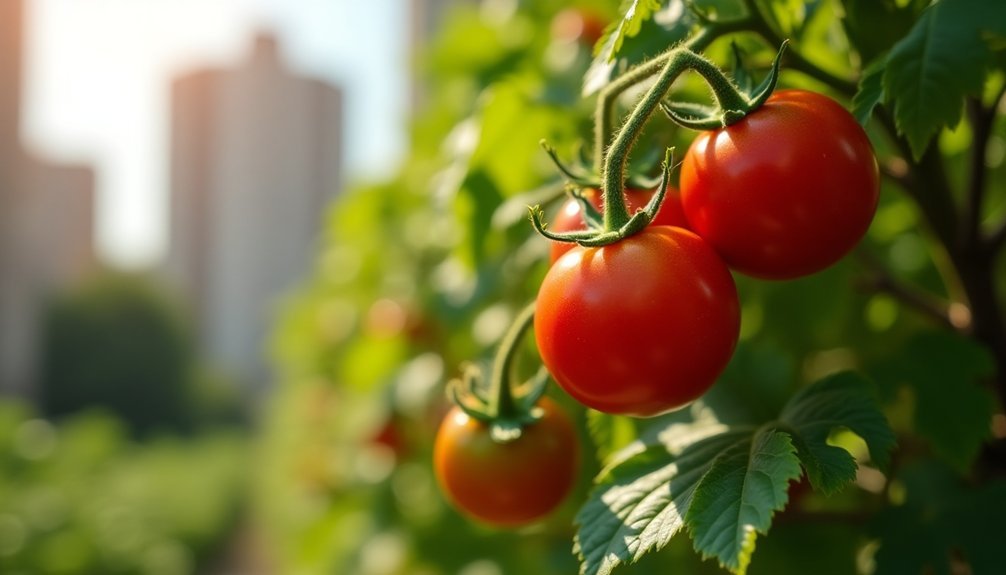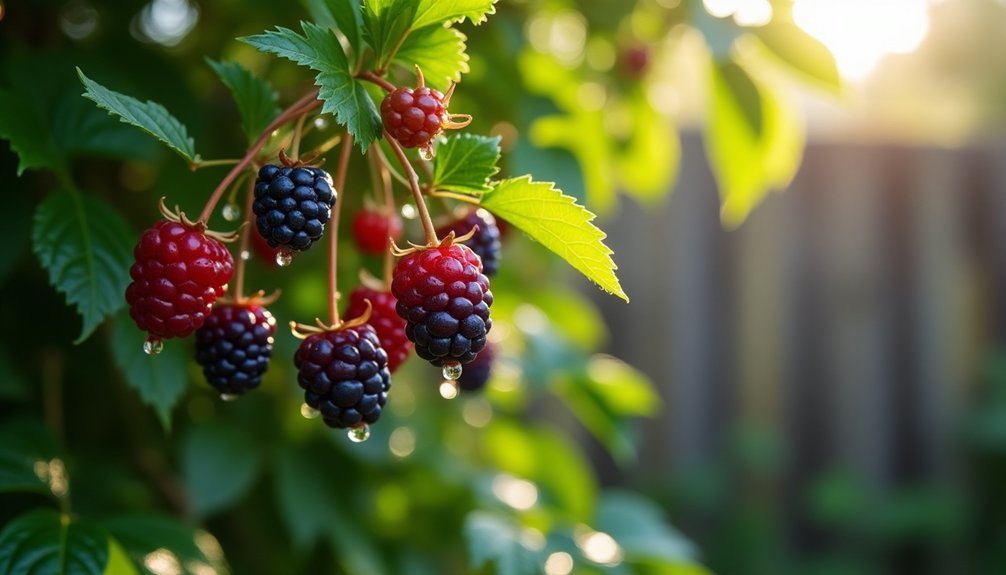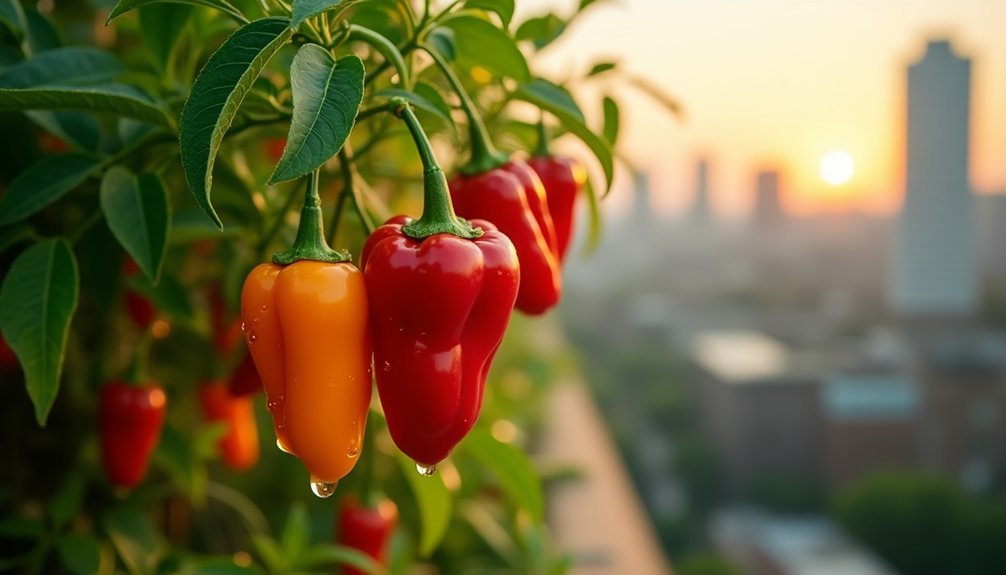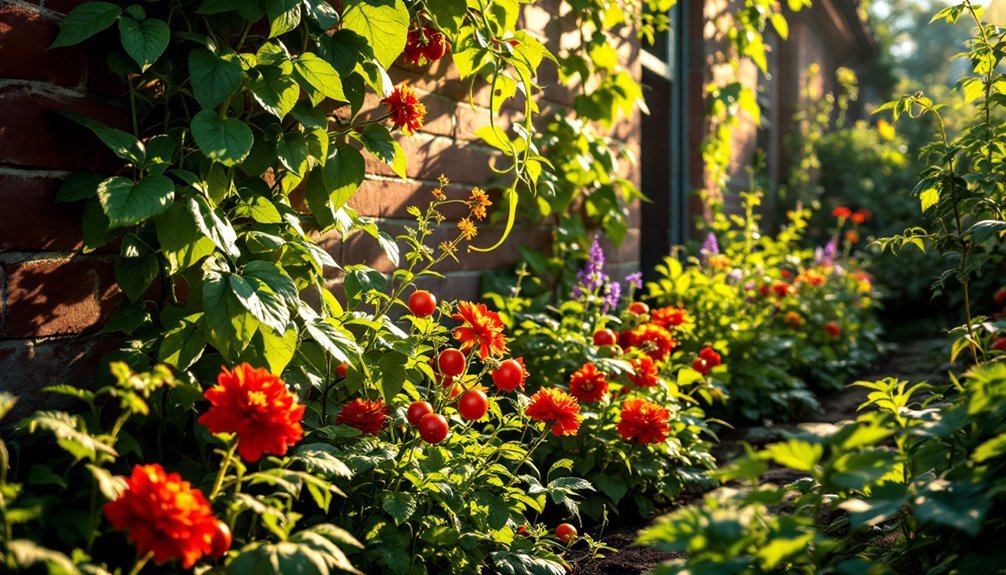City gardeners, here are seven plants with their ideal harvesting times: Pick tomatoes when soft yet firm with a gentle tug; harvest herbs in early morning when oils are strongest; collect berries when fully colored and release easily; cut greens before they droop; harvest peppers as they reach desired color; gather urban fruits when slightly soft; and collect vertical vegetables regularly to encourage growth. Discover how these timing secrets can transform your compact garden's productivity.
Tomatoes: Ripeness Signs for Urban Balconies

How can city dwellers know when their balcony tomatoes are perfectly ripe? Look beyond color alone—ripe tomatoes feel soft yet firm, with glossy skin and a subtle sweet fragrance. They'll detach easily from the vine with a gentle twist. Remember that true ripeness is determined by feeling for softness, not by the color of your tomatoes.
For successful balcony growing, place containers in spots that receive adequate sunlight but provide shade during peak hours to prevent sunscald.
Water consistently without overdoing it. Use trellises or cages to support upward growth and improve fruit accessibility.
If you've harvested too early, place green tomatoes indoors at 70°F with an apple nearby—the ethylene gas will accelerate ripening.
Remember that different varieties take anywhere from 42 to 110 days to mature, with weather conditions affecting both speed and quality of ripening.
Window Herbs: Harvesting Guide for City Apartments
While tomatoes brighten urban balconies with their vibrant presence, window herbs transform ordinary apartments into aromatic culinary gardens. For ideal growth, position your herbs at south or southwest-facing windows where they'll receive 4-6 hours of sunlight daily.
Harvest your herbs in the early morning when they're dry but full of flavor. Use clean, sharp scissors to prevent disease transfer, cutting just above leaf nodes to encourage branching and bushier growth.
- Soft herbs like cilantro and parsley thrive from seed and should be cut from the outside in.
- Woody herbs such as thyme and rosemary can be potted from outdoor divisions.
- Remove flowers (except for decoration) to maintain leaf flavor intensity.
- Store freshly harvested herbs in water in your refrigerator or dry them for year-round use.
Remember to follow the Golden Rule of harvesting no more than one-third of any herb plant weekly to ensure healthy regrowth and continuous production.
Berries From Backyard Patches: Timing Your Harvest

Tucked away in urban spaces, berry patches offer city dwellers a sweet taste of countryside living right in their backyards. For ideal flavor, harvest your berries in early morning when they're sweetest and temperatures are cool.
Each berry reveals its readiness differently: raspberries should release easily when tugged; strawberries need full redness with a shine; blueberries are ready when uniformly dark blue; blackberries are best slightly past their glossy phase; and currants should reach full color and softness.
The language of ripeness: each berry type speaks through color, texture and resistance, revealing precisely when it's ready for your basket.
Handle your harvest gently, using fingers rather than gloves for delicate varieties. For efficient collection, use buckets or harvesting aprons. Harvesting too early can result in sour berries, especially with blackberries, so patience is key.
After picking, refrigerate promptly—raspberries last 3-5 days, while currants can keep for two weeks. Design your patch with accessible pathways and proper spacing to make future harvests easier.
Container Greens: Peak Picking Seasons in Limited Spaces
Container gardening transforms even the tiniest balconies and windowsills into productive green spaces for urban gardeners. Most leafy greens thrive in compact environments when given proper care and harvested at the right time.
Your container greens reach peak flavor at different stages. Harvest spinach when leaves reach 6-8 inches, while kale tastes best after a light frost. Lettuce should be picked in the morning before leaves droop, and Swiss chard can be continuously harvested as it regrows. For optimal quality and nutrition, harvest your container greens in the evening hours when nitrate levels are naturally lower.
- Most greens prefer cooler temperatures (50-70°F) and 4-6 hours of daily sunlight
- Choose containers at least 6-8 inches deep for proper root development
- Vertical planting and intercropping maximize your limited space
- Regular harvesting of young leaves encourages new growth and extends production
Rooftop Peppers: Color Indicators for Maximum Flavor

Rooftop gardens offer the perfect environment for growing peppers, those vibrant jewels that transform from humble green to a spectacular array of colors as they ripen. When harvesting your urban pepper crop, color is your most reliable indicator of flavor and nutritional content.
| Pepper Color | Flavor Profile | Best Uses |
|---|---|---|
| Green | Slightly bitter, grassy | Stir-fries, salads |
| Yellow/Orange | Medium sweetness, fruity | Raw snacking, roasting |
| Red | Sweetest, rich, fruity | Raw consumption, sauces |
Wait for peppers to reach their final colors for maximum sweetness and nutrients—red peppers contain considerably more vitamins A and C than their green counterparts. For ongoing harvests throughout the season, implement succession planting techniques. Remember, green peppers aren't a different variety—they're simply unripe versions of colored peppers. The California Wonder variety, a classic bell pepper that transitions from green to vibrant red, is ideal for urban gardeners seeking high vitamin C content.
Urban Fruit Trees: Neighborhood Harvesting Calendar
Urban fruit trees offer a bounty of free, local produce that changes with the seasons, yet many city residents don't realize when these neighborhood treasures are ready for picking.
Community-based initiatives like Urban Edibles and Not Far From The Tree coordinate volunteers to guarantee fruit doesn't go to waste. A comprehensive free calendar is available to help urban foragers identify optimal harvesting times throughout the year.
You'll find different fruits ready throughout the year:
- Late Summer to Early Fall: Apple and pear trees reach their peak ripeness
- Mid to Late Summer: Look for stone fruits like peaches, apricots, and plums
- Spring to Early Summer: Berry bushes offer delicious harvests
- Year-Round in Warm Climates: Citrus and fig trees produce continually
Vertical Garden Vegetables: Optimal Collection Times
Vertical gardens provide an efficient solution for growing vegetables in limited urban spaces, but knowing exactly when to harvest your bounty requires attention to detail.
Harvest leafy greens in the morning when they're crisp, and pick vining vegetables after the dew dries but before midday heat.
Your harvest timing can be influenced by several factors: increased sunlight exposure in vertical setups often speeds ripening, while good air circulation reduces disease. Consider doing daily garden visits to properly track vegetable development and identify perfect harvest windows.
For specific vegetables, harvest baby carrots when they're 1/2 inch thick, snap peas when pods become plump, and squash at ideal size and color.
You'll benefit from vertical gardening's improved visibility, making it easier to monitor plant maturity.
Training vines on trellises and selecting compact varieties will maximize your limited space while ensuring a diverse, year-round harvest.
Frequently Asked Questions
How Does Pollution Affect Urban Produce Safety?
You'll face health risks from urban produce due to soil's heavy metals, polluted irrigation water's contaminants, and air pollution's particulate deposits. These affect crop quality, taste, and can cause long-term health issues.
Can City-Grown Fruits Ripen After Harvesting?
Yes, city-grown climacteric fruits like tomatoes, apples, and bananas will ripen after you've picked them. But you'll need to harvest non-climacteric fruits like strawberries and citrus when they're fully ripe.
What Tools Are Best for Harvesting in Tight Spaces?
For harvesting in tight spaces, you'll find compact harvest scissors, curved shears, and bypass pruners most effective. They'll fit in your palm, allowing precise cuts without damaging surrounding plants while reducing hand fatigue.
How Do Companion Plants Affect Harvest Timing?
Companion plants can accelerate or delay your harvests by affecting soil nutrients, deterring pests, and attracting pollinators. You'll find that strategic pairings like the Three Sisters method optimize space and extend your harvesting season.
Do Urban Heat Islands Change Optimal Harvest Schedules?
Yes, you'll need to harvest earlier in urban heat islands. They accelerate plant maturation and ripening, forcing adjustments to traditional harvest schedules. Monitor your plants closely for earlier signs of readiness.
In Summary
You're now equipped to harvest like a pro in your urban jungle! Remember, timing is everything—watch those ripeness signs, follow seasonal patterns, and don't hesitate to taste test. With practice, you'll develop an instinct for perfect picking moments. Urban gardening isn't just about growing; it's about harvesting at precisely the right time for maximum flavor and nutrition from your city oasis.





Leave a Reply